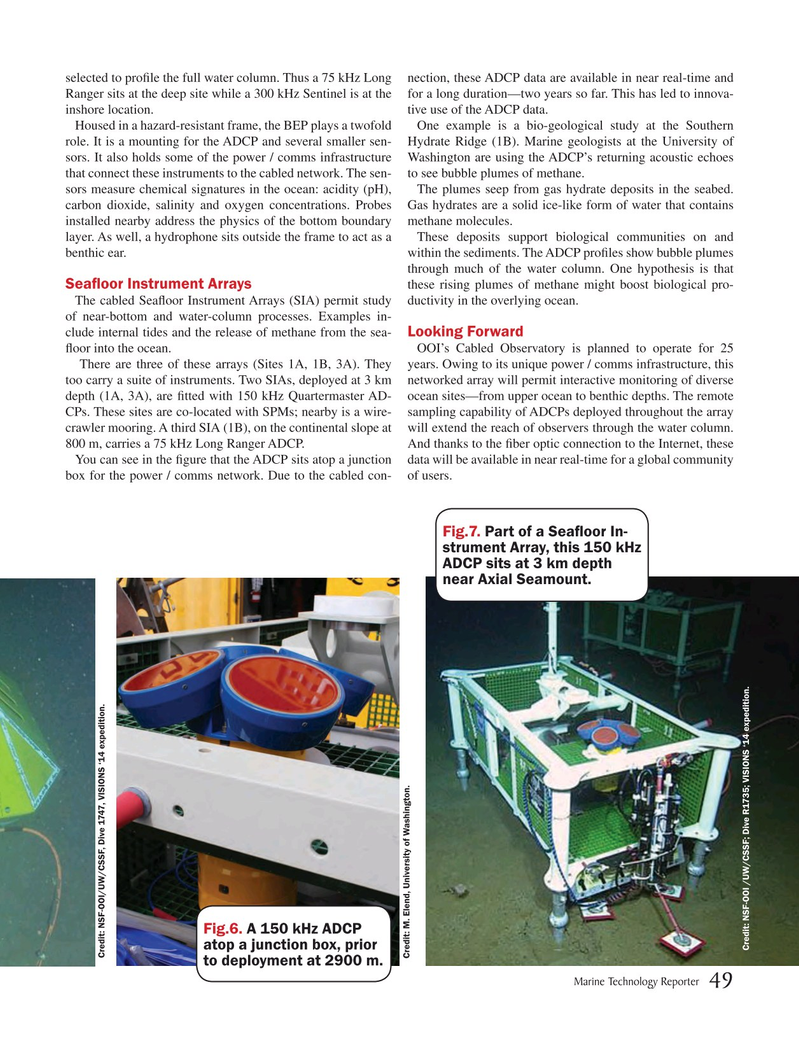
Page 49: of Marine Technology Magazine (March 2018)
Oceanographic Instrumentation: Measurement, Process & Analysis
Read this page in Pdf, Flash or Html5 edition of March 2018 Marine Technology Magazine
selected to pro? le the full water column. Thus a 75 kHz Long nection, these ADCP data are available in near real-time and
Ranger sits at the deep site while a 300 kHz Sentinel is at the for a long duration—two years so far. This has led to innova- inshore location. tive use of the ADCP data.
Housed in a hazard-resistant frame, the BEP plays a twofold One example is a bio-geological study at the Southern role. It is a mounting for the ADCP and several smaller sen- Hydrate Ridge (1B). Marine geologists at the University of sors. It also holds some of the power / comms infrastructure Washington are using the ADCP’s returning acoustic echoes that connect these instruments to the cabled network. The sen- to see bubble plumes of methane. sors measure chemical signatures in the ocean: acidity (pH), The plumes seep from gas hydrate deposits in the seabed. carbon dioxide, salinity and oxygen concentrations. Probes Gas hydrates are a solid ice-like form of water that contains installed nearby address the physics of the bottom boundary methane molecules. layer. As well, a hydrophone sits outside the frame to act as a These deposits support biological communities on and benthic ear. within the sediments. The ADCP pro? les show bubble plumes through much of the water column. One hypothesis is that
Sea? oor Instrument Arrays these rising plumes of methane might boost biological pro-
The cabled Sea? oor Instrument Arrays (SIA) permit study ductivity in the overlying ocean.
of near-bottom and water-column processes. Examples in- clude internal tides and the release of methane from the sea- Looking Forward ? oor into the ocean. OOI’s Cabled Observatory is planned to operate for 25 There are three of these arrays (Sites 1A, 1B, 3A). They years. Owing to its unique power / comms infrastructure, this too carry a suite of instruments. Two SIAs, deployed at 3 km networked array will permit interactive monitoring of diverse depth (1A, 3A), are ? tted with 150 kHz Quartermaster AD- ocean sites—from upper ocean to benthic depths. The remote
CPs. These sites are co-located with SPMs; nearby is a wire- sampling capability of ADCPs deployed throughout the array crawler mooring. A third SIA (1B), on the continental slope at will extend the reach of observers through the water column. 800 m, carries a 75 kHz Long Ranger ADCP. And thanks to the ? ber optic connection to the Internet, these
You can see in the ? gure that the ADCP sits atop a junction data will be available in near real-time for a global community box for the power / comms network. Due to the cabled con- of users.
Fig.7. Part of a Sea? oor In- strument Array, this 150 kHz
ADCP sits at 3 km depth near Axial Seamount.
Fig.6. A 150 kHz ADCP atop a junction box, prior
Credit: NSF-OOI /UW/CSSF; Dive R1735; VISIONS ‘14 expedition.
Credit: M. Elend, University of Washington.
Credit: NSF-OOI/UW/CSSF, Dive 1747, VISIONS ‘14 expedition.
to deployment at 2900 m.
Marine Technology Reporter 49
MTR #2 (34-49).indd 49 MTR #2 (34-49).indd 49 2/20/2018 4:16:27 PM2/20/2018 4:16:27 PM

 48
48

 50
50
